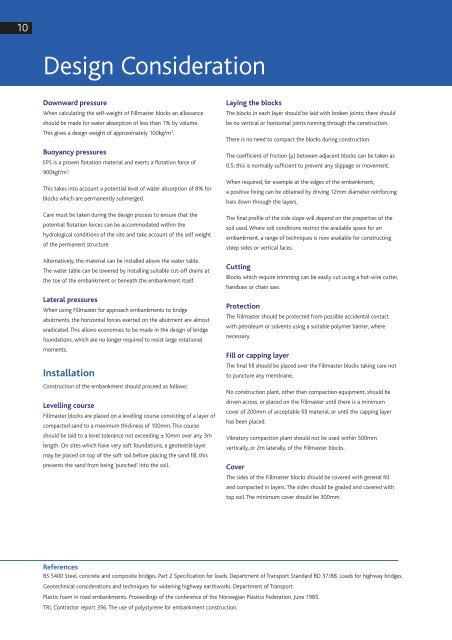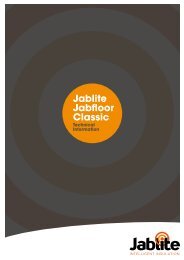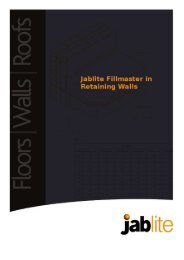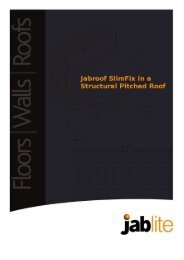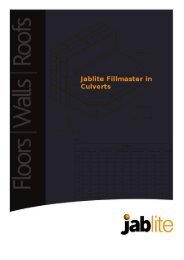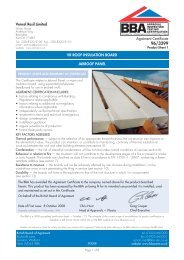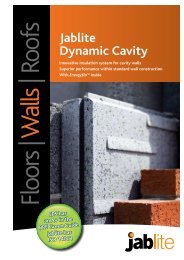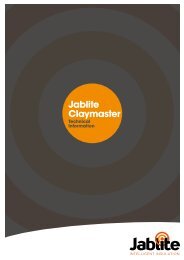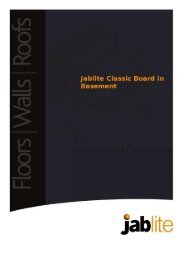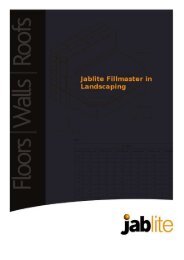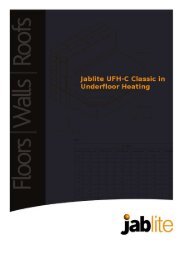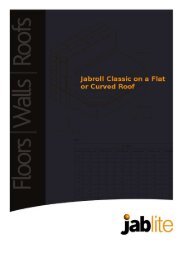Jablite Fillmaster in Floor Raising
Jablite Fillmaster in Floor Raising
Jablite Fillmaster in Floor Raising
Create successful ePaper yourself
Turn your PDF publications into a flip-book with our unique Google optimized e-Paper software.
10<br />
Design Consideration<br />
Downward pressure<br />
When calculat<strong>in</strong>g the self-weight of <strong>Fillmaster</strong> blocks an allowance<br />
should be made for water absorption of less than 1% by volume.<br />
This gives a design weight of approximately 100kg/m 3 .<br />
Buoyancy pressures<br />
EPS is a proven flotation material and exerts a flotation force of<br />
900kgf/m 3 .<br />
This takes <strong>in</strong>to account a potential level of water absorption of 8% for<br />
blocks which are permanently submerged.<br />
Care must be taken dur<strong>in</strong>g the design process to ensure that the<br />
potential flotation forces can be accommodated with<strong>in</strong> the<br />
hydrological conditions of the site and take account of the self weight<br />
of the permanent structure.<br />
Alternatively, the material can be <strong>in</strong>stalled above the water table.<br />
The water table can be lowered by <strong>in</strong>stall<strong>in</strong>g suitable cut-off dra<strong>in</strong>s at<br />
the toe of the embankment or beneath the embankment itself.<br />
Lateral pressures<br />
When us<strong>in</strong>g <strong>Fillmaster</strong> for approach embankments to bridge<br />
abutments, the horizontal forces exerted on the abutment are almost<br />
eradicated. This allows economies to be made <strong>in</strong> the design of bridge<br />
foundations, which are no longer required to resist large rotational<br />
moments.<br />
Installation<br />
Construction of the embankment should proceed as follows:<br />
Levell<strong>in</strong>g course<br />
<strong>Fillmaster</strong> blocks are placed on a levell<strong>in</strong>g course consist<strong>in</strong>g of a layer of<br />
compacted sand to a maximum thickness of 100mm. This course<br />
should be laid to a level tolerance not exceed<strong>in</strong>g ±10mm over any 3m<br />
length. On sites which have very soft foundations, a geotextile layer<br />
may be placed on top of the soft soil before plac<strong>in</strong>g the sand fill, this<br />
prevents the sand from be<strong>in</strong>g ‘punched’ <strong>in</strong>to the soil.<br />
Lay<strong>in</strong>g the blocks<br />
The blocks <strong>in</strong> each layer should be laid with broken jo<strong>in</strong>ts; there should<br />
be no vertical or horizontal jo<strong>in</strong>ts runn<strong>in</strong>g through the construction.<br />
There is no need to compact the blocks dur<strong>in</strong>g construction.<br />
The coefficient of friction (µ) between adjacent blocks can be taken as<br />
0.5; this is normally sufficient to prevent any slippage or movement.<br />
When required, for example at the edges of the embankment,<br />
a positive fix<strong>in</strong>g can be obta<strong>in</strong>ed by driv<strong>in</strong>g 12mm diameter re<strong>in</strong>forc<strong>in</strong>g<br />
bars down through the layers.<br />
The f<strong>in</strong>al profile of the side slope will depend on the properties of the<br />
soil used. Where soil conditions restrict the available space for an<br />
embankment, a range of techniques is now available for construct<strong>in</strong>g<br />
steep sides or vertical faces.<br />
Cutt<strong>in</strong>g<br />
Blocks which require trimm<strong>in</strong>g can be easily cut us<strong>in</strong>g a hot-wire cutter,<br />
handsaw or cha<strong>in</strong> saw.<br />
Protection<br />
The <strong>Fillmaster</strong> should be protected from possible accidental contact<br />
with petroleum or solvents us<strong>in</strong>g a suitable polymer barrier, where<br />
necessary.<br />
Fill or capp<strong>in</strong>g layer<br />
The f<strong>in</strong>al fill should be placed over the <strong>Fillmaster</strong> blocks tak<strong>in</strong>g care not<br />
to puncture any membrane.<br />
No construction plant, other than compaction equipment, should be<br />
driven across, or placed on the <strong>Fillmaster</strong> until there is a m<strong>in</strong>imum<br />
cover of 200mm of acceptable fill material, or until the capp<strong>in</strong>g layer<br />
has been placed.<br />
Vibratory compaction plant should not be used with<strong>in</strong> 500mm<br />
vertically, or 2m laterally, of the <strong>Fillmaster</strong> blocks.<br />
Cover<br />
The sides of the <strong>Fillmaster</strong> blocks should be covered with general fill<br />
and compacted <strong>in</strong> layers. The sides should be graded and covered with<br />
top soil. The m<strong>in</strong>imum cover should be 300mm.<br />
References<br />
BS 5400 Steel, concrete and composite bridges. Part 2 Specification for loads. Department of Transport Standard BD 37/88. Loads for highway bridges.<br />
Geotechnical considerations and techniques for widen<strong>in</strong>g highway earthworks. Department of Transport.<br />
Plastic foam <strong>in</strong> road embankments. Proceed<strong>in</strong>gs of the conference of the Norwegian Plastics Federation. June 1985.<br />
TRL Contractor report 356. The use of polystyrene for embankment construction.


